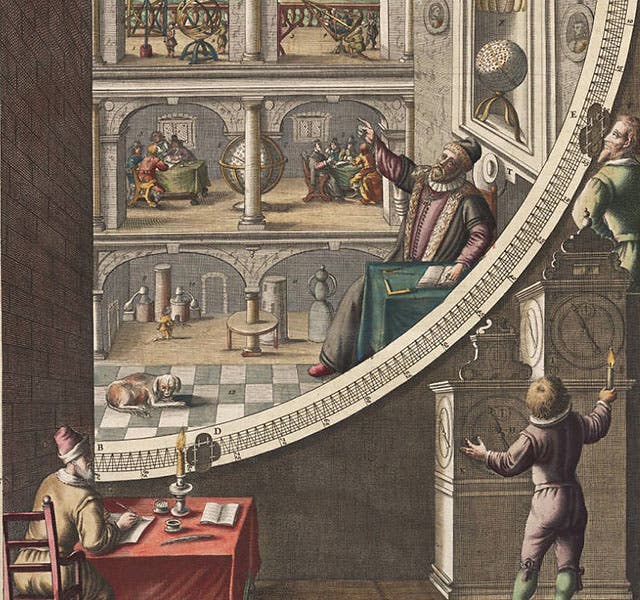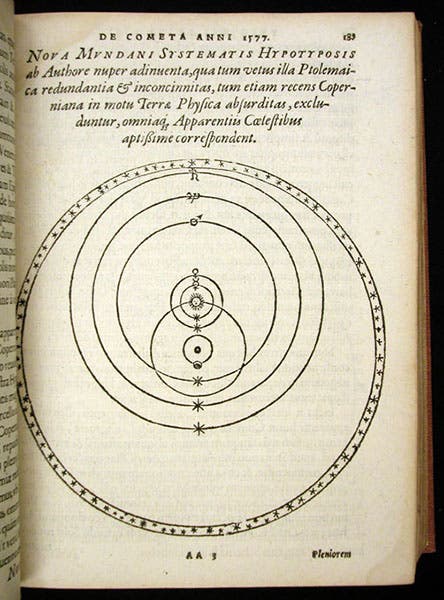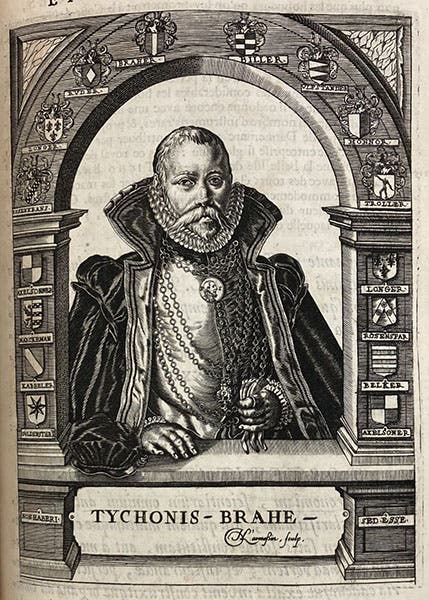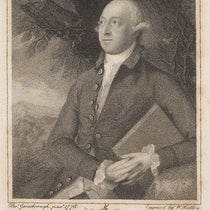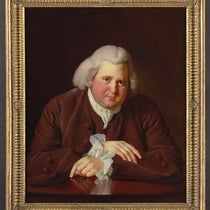Scientist of the Day - Tycho Brahe
Tycho Brahe, a Danish astonomer, died in Prague on Oct. 24, 1601, at age 54. Tycho is the best known of all Renaissance astronomers except Nicolaus Copernicus , who died in 1543, before Tycho was even born (in 1546). We have published two posts on Brahe, the first a general discussion of his fame and accomplishments, and the second looking in more detail at his star catalog, his relationship with Johannes Kepler, and his manner of dying, which was not pleasant. But in those two posts, we barely mentioned a proposal he made in 1588 that was perhaps his most influential idea. In that year, he proposed a new cosmology, an ordering of the heavenly bodies, as an alternative to the new heliocentric cosmology of Copernicus, and the ancient earth-centered systm of Aristotle and Ptolemy of Alexandria. We will expand on this today.
The geocentric cosmology proposed by Aristotle in his book On the Heavens, and turned into an astronomical system by Ptolemy, is fairly simple to describe (third image). The Earth is the center of the cosmos and does not move or rotate. It is immediately surrounded by the "elemental world," the home of earth, water, air and fire, which is bounded by the orb of the Moon. The Moon is the innermost of the planets and is located on an invisible solid sphere, made of quintessence, like all heavenly objects. Outside the Moon is the sphere of Mercury, then that of Venus, the Sun, Mars, Jupiter, and Saturn, all within a single sphere containing all the stars. Each of these spheres rotates around the Earth at a rate sufficient to produce, more or less, the observed motions of the planets. The sphere of stars rotates once every 24 hours.
In Ptolemy’s system, things got much more complicated, for if you assume planets move on spheres with a simple rotation, you cannot reproduce their actual motions, so Ptolemy used a system of circles moving on circles – epicycles and deferents – to predict planetary motion, but the epicycles and deferents were centered on the Earth, so it was still a geocentric system.
Copernicus in 1543 turned Ptolemaic astronomy inside out, putting the Sun at the center of planetary movement and setting the Earth in motion, both around the Sun and in rotation on its axis (fourth image). The Copernican system did not work any better than the Ptolemaic system. But it did mandate an order for the planets (which was arbitrary in the geocentric system), and it did explain in a more satisfying manner what was called retrograde motion, where the planets, for brief but regular periods, appear to move backwards against the stars. And significantly, the Copernican system put the stars at rest, meaning they did not have to be on a sphere, and could float free in space.
The principal problem with Copernicanism, for many, including Tycho, is that if you want to make it the basis of a cosmology (as Copernicus did), you need to be able to explain why it doesn’t feel like the Earth is moving – you need to provide a physics for a rotating Earth, which was not available in 1543, or in 1600. You also needed to explain why the stars do not seem to shift back and forth as the Earth circles the Sun – why you cannot detect stellar parallax, as it was called.
Tycho admired Copernicus, and the explanatory power of his Sun-centered orbits. But a moving Earth was for Tycho a physical impossibility, and he found the lack of stellar parallax to be a serious obstacle. Moreover, unlike the Catholic Copernicus, the Lutheran Brahe found the proposed motion of the Earth to be in conflict with numerous passages in Scripture that seem to mandate a motionless Earth. So Tycho proposed a cosmological system in which all the planets except the Moon orbited the Sun, but the Sun (with all its planets) and Moon and stars then circled a stationary and central Earth (fifth image).
An interesting corollary of the Tychonic system, as it came to be called, was that, by his measurements, Mars sometimes comes closer to us than the Sun, so that their orbits overlap, making it impossible for them to be on solid spheres. So if you accepted the Tychonic system, you had to give up the idea of celestial spheres.
The Tychonic system got off to a slow start, but when Copernicanism was condemned by the Church in 1616, the Tychonic system became a popular alternative to heliocentrism, especially among the Jesuits. A typical discussion of cosmologies in an astronomical text from 1616 to 1660 would explain and diagram the ancient, Copernican, and Tychonic systems, and then, more likely than not, opt for the Tychonic system as the one that is best in accord with both observation and Scripture. Even Protestant writers such as Johannes Hevelius found it desirable to present all three systems as viable possibilities, as Hevelius did in the introduction to his book on the Moon, the Selenographia (1647; sixth image). Our first image shows a detail of a plate in the Harmonia macrocosmica of Andreas Cellarius (1661), depicting the Tychonic systm.
And when the Jesuit Giovanni Battista Riccioli published his massive astronomical encyclopedia, Almagestum novum (1651), he offered up six cosmologies, with the Copernican and Tychonic systems being most preferable (seventh image), and on the engraved frontispiece he presented an elaborate allegory in which the Copernican system was “weighed” against a modified Tychonic system, and lost, as the testimony of Scripture cave added weight to the earth-centered cosmology (eighth image).
In our first two posts, we showed you most of the portraits of Tycho Brahe in our collections; there remains only an engraving in the portrait book of Isaac Bullart, Academie des sciences et des arts (1682), which is a fine early impression (ninth image).
And since this is the anniversary of Tycho’s death, we show you the Church of Our Lady before Týn in Prague, where Tycho is buried. You can see his grave plaque in our second post on Tycho, where it is the last image.
William B. Ashworth, Jr., Consultant for the History of Science, Linda Hall Library and Associate Professor emeritus, Department of History, University of Missouri-Kansas City. Comments or corrections are welcome; please direct to ashworthw@umkc.edu.



